
Are all lubricity products equal?
With such huge pressures on refiners to manage supply and demand imbalances, excacerbated by the increased demand for bio fuel products and the challenges of IMO 2020, it is reassuring to know that MULTISOL, utilising INFINEUM’s proven world class range of products, is positioned to support refiners across the globe. Achieving the right outcome requires robust testing protocols to fully assess product and field performance. Multisol’s state of the art laboratories in Moscow and Poznan provide refiners with the highest standards of technical support and a range of testing capability. These centres of excellence meet Infineum’s exacting standards and provide refiners with a seamless operation from which to deliver their product targets and improve their economics.
In the latest Insight (25th September 2019) from Infineum International, Dean Clark, Infineum Fuels Venture Manager deals with the importance, with such a variety of raw materials available for use in the production of diesel lubricity products, of thorough testing procedures.
Lubricity additives have been used in diesel fuels for many years to reduce wear on engine components, particularly the fuel pump, to prevent engine breakdown. With the advent of ultra low sulphur diesel, lubricity additives became a requirement in most fuels to meet either the ASTM D975 or EN590 global specifications for diesel. The performance of the fuel is determined using the high frequency reciprocating rig (HFRR), ball on metal test, which measures the diameter of the flattening of the ball after the test in µm, with a lower result being better.
Infineum recently carried out a study looking at a high number of finished lubricity solutions available in the marketplace today as well as the wide variation of raw material sources used for lubricity.
There are two primary chemistry solutions for lubricity improvers – neutral or acidic – which behave differently in fuel.
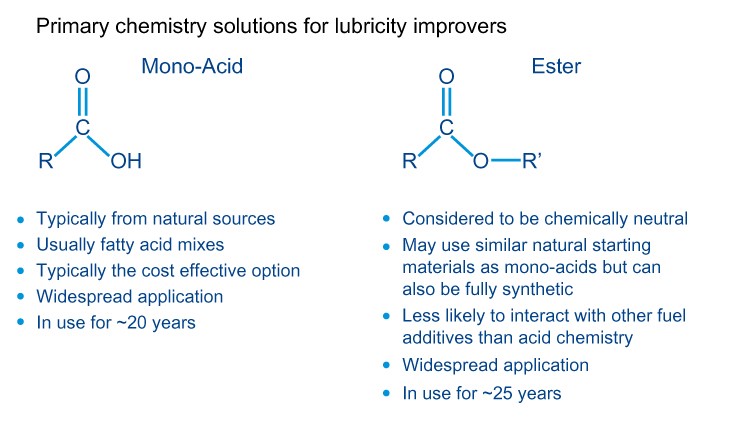
This article highlights the variations in the monoacid lubricity solutions available today and the importance of selection for both the robustness of products as well as the more typical economic benefits.
Monoacids used for lubricity are typically oleic, linoleic, palmitic and linolenic. These come from natural resources such as tall oil, rapeseed, soy, sunflower, tallow, coconut and palm oils, which can suffer with seasonal variability. The mix of these various acids is key to both product stability and lubricity performance. As an example, Infineum experience shows that the ratio of C18:1 (describes an 18-carbon chain with one double bond in it) and C18:2 (18-carbon chain with two double bonds) content in the fatty acid distribution directly impacts on low temperature and oxidative/thermal stability.
Fatty acid manufacturers have a very limited set of specification parameters due to: A) the wide variation of uses for the fatty acid and B) the basic specification allows the wider use of lower grade acids. For lubricity we are looking at many other aspects and potentially co-mingling fatty acids to improve performance in fuel while at the same time finding the most cost effective product. It is important to remember that traditionally fatty acids are more often used in commoditised markets such as components in many foods, emulsifying agents in soaps, solubilising agents in aerosols and many more applications. Indeed, many natural acid sources would provide a level of HFRR performance should that be the only parameter needed. The balance between cost and sustainable lubricity performance is delicate however, robust and reliable overall performance is critical to refinery operations.
Infineum has identified four areas that in our experience are important to customers: product performance, handleability, product quality and safety.
Product performance
This would be typically determined by using the fuels in question in the HFRR test, a measurement for lubrication of diesel or heating oil. Infineum played a major role in the development of this test around 25 years ago to measure the lubricity of diesel fuel. Vehicle manufacturers see diesel fuel lubricity as a critical parameter. Infineum has been monitoring the performance of diesel fuel for over 30 years in its Worldwide Winter Diesel Fuel Quality Survey, click here for the 2018 Survey to see the latest HFFR trends.
At the refinery for example, the lubricity additive should be able to meet the requirements of customers’ traditional fuels and be able to add additional security where there are diesel fuel pools that contain intermittently severe fuels. This could be more prevalent during the coming months as the industry work towards meeting International Maritime Organization 2020 requirements for low sulphur in marine fuels, a key change which is expected to drive additional complexity and variability in the fuels pool.
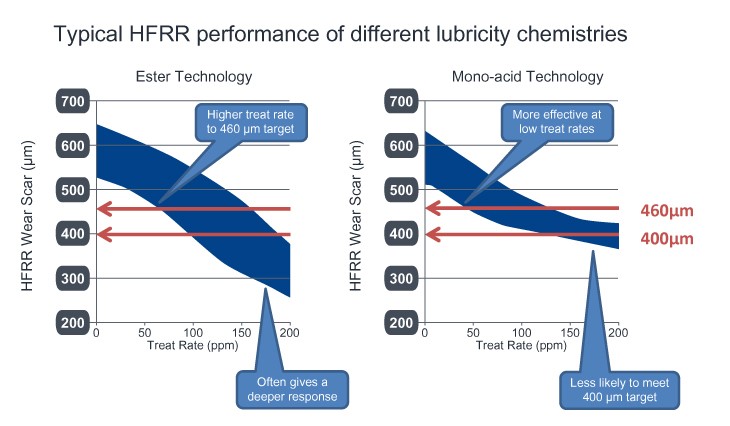
Product screening tests
Infineum adopts a very thorough qualification process for raw material suppliers and uses a number of different tests to screen materials used for our lubricity additives. The tests vary and some are more relevant dependent on the acid source. The results versus our robust specifications allow us to predict certain product performance. Our specifications for these tests are the result of our understanding, built over many years, of the links between certain parameters and product performance, handleability, product quality and safety. Testing includes appearance, acid number, colour, cloud point, water, density, pour point, sulphur and unsaponifiable, to name but a few.
Handleability
The product minimum loading/handling temperature is a key area for operators within a refinery. An appearance and colour specification are used to ensure the product is visually consistent from batch to batch. Both can detect possible contamination of the product: Appearance could detect crystals or water if cloudy, colour could detect oxidation in case of darker colour than usual. Kinematic viscosity, density, cloud point and pour point parameters help to determine the product cold properties and provide indications for use, storage and handling. The product must also show good compatibility with the local fuel while also remaining stable at lower temperatures over an extended period.
Product Quality
This can be seen from many angles from either delivered product repeatability to product performance in fuel or indeed any areas in between. Water contamination levels of a product play a key role. A very tight water specification is needed as water represents a potentially hazardous contamination (for metal hardware for example) and will generally rise the longer a product is in contact with air, through transport, storage tanks and the wider supply chain.
Additional parameters, such as unsaponifiable, detect heavy insoluble molecules present in the sample, which ultimately could cause operability issues. Acid number and fatty acid distribution together provide information on the product chemical composition, hence ensuring consistency from batch to batch. Density relates to the type of molecules present in the sample, acid number to the chemically active part of those molecules and fatty acid distribution to their degree of unsaturation. Sulphur level also is a requirement for export in certain regions, and in final fuels as it is toxic for catalysts used in post-combustion treatments.
As mentioned above the interaction with metal surfaces and basic compounds in diesel fuel as well as the ability to meet the product description and colour, time and time again are pillars in a robust supply chain and should be expected by the customer.
Safety
When developing products, their ability to be safely handled is paramount in our thinking and a robust flash point parameter is a key part of our specifications.
To meet the key customer performance parameters Infineum runs a significant suite of in-house tests together with DGMK (German Fuels Additive Testing) protocols and EI1535 multiproduct pipeline protocols. These measure haze, corrosion, particulate suspension, anti-foaming, cold flow interaction, static stability, water contamination and many more. The results of such tests have been used to develop robust manufacturing specifications.
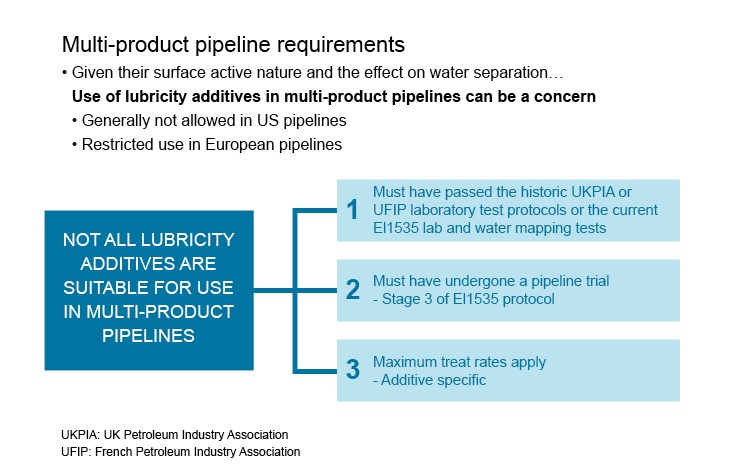
Assessing monoacids
The Infineum study looked at 116 samples from various fatty acid sources, regions, and suppliers. These were assessed on a wider range of tests, but here we look at fatty acid distribution, acid number, pour point, cloud point and water content. We typically look for abnormalities that potentially would impact one of our four customer attributes product performance, handleability, product quality and safety. In this example we look at two products, A and B.
Product A is a well-established monoacid with more than 10 years in field usage while product B has limited known usage. Product A and B have identical sourced raw materials and HFRR performance is similar for both products. A closer look using a wider range of testing was performed.
For example, acid number and fatty acid distribution together provide information on the product chemical composition. In Infineum’s extensive experience, these two parameters help to predict overall performance and consistency from batch to batch.

Product A, as expected, falls within our acid number manufacturing range while product B shows a much lower acid number. The fatty acid distributions show that while product A is within our range for oleic vegetable-based materials, product B shows a significantly higher result, outside of our specification range for the relevant fatty acid.
Cloud point and pour point parameters are used to help to determine the cold properties of the products and to provide indications for use, storage and handling.
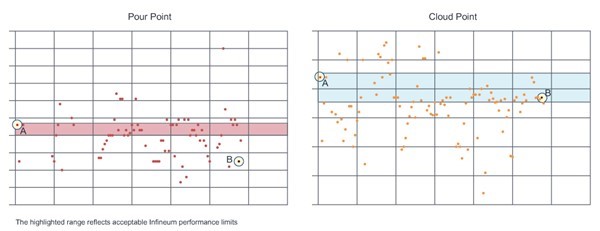
While product A falls within range for this type of raw material product B shows a surprising low pour point. This could indicate some additional ingredient (e.g. solvent) or unusual ratio of C18:1 and C18:2 content in the fatty acid distribution. In turn this could impact low temperature and oxidative/thermal stability so in the case of product B further testing would be required.
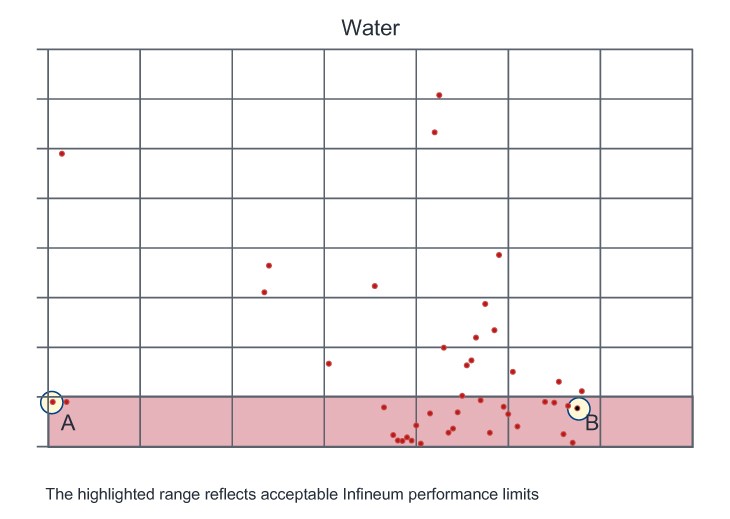
The chart above shows that product A and B are both just within our acceptable water limits. Our manufacturing water limits for lubricity products are extremely tight to allow for the natural buildup of condensation during transportation. Though the limits exclude a number of raw material suppliers we believe that this is justified given water contamination remains a key issue in the wider supply chain.
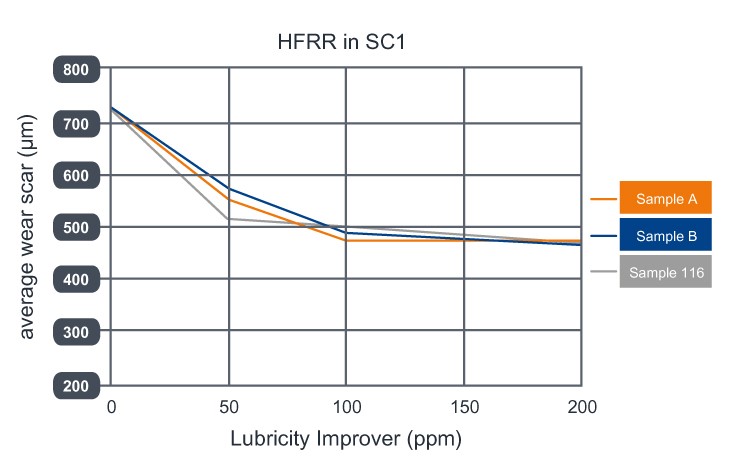
HFRR testing revealed comparative HFRR performance for samples A and B, shown above, with an additional monoacid sample. There is no significant difference in HFRR performance in this SC1 (Swedish class I) type fuel.
This is only a snapshot of the overall testing carried out in the study. A more holistic review of the data shows the following:
- Acid number – 19 samples out of 116 were outside our acid number parameters and 30* samples offered no data (as they were discarded earlier in the process).
- Pour point – 30 samples were within our pour point vegetable based oleic range and 39* samples offered no data.
- Cloud point – 44 samples out of 116 were within our cloud point parameters for vegetable based oleic acids and 12* samples offered no data.
- Fatty acid distribution – 43 samples were within our vegetable based oleic range.
- Water – 19 samples out of 116 were outside our acceptable water parameters.
*Samples offering no data are typically where certain base criteria are not met so further progression of those samples were stopped as would not meet Infineum standards. Only 14 samples out of 116 had the potential to meet Infineum’s exacting standards.
Conclusions
Our conclusions from this study are that monoacids form a key part of the industry’s lubricity solutions, together with higher performing ester products. Monoacids are not equal in overall performance. The natural resources in monoacids have an inherent seasonal variability so well-defined risk based specifications are vital to ensure product quality. Our in-house proprietary manufacturing specifications are based on many years of experience. Whilst not perfect, they do provide us with a robust mechanism to establish products that meet the most demanding needs of all our customers.
Though product cost and refinery economics form a large part of the decision making process when purchasing lubricity products, the industry needs to continue to look at robustness of performance for any additive used in the diesel pool.
Our study suggests that there are a high number of materials in the market offering lubricity solutions today, however many of them include increased risk to operational excellence.
Operational excellence at refineries has a significant impact on the overall economics, well beyond the monetary cost of lubricity, and therefore the need to look at these additives in detail is critical. HFRR alone does not distinguish the differing aspects of product quality or determine operational impact. After all lubricity additives are not created equal.